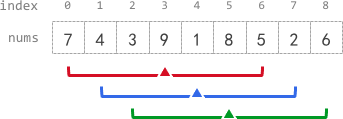- {x}
- The Number of Rich Customers
- Substrings That Begin and End With the Same Letter
- Drop Type 1 Orders for Customers With Type 0 Orders
- Count Common Words With One Occurrence
- Minimum Number of Food Buckets to Feed the Hamsters
- Minimum Cost Homecoming of a Robot in a Grid
- Count Fertile Pyramids in a Land
- Find Target Indices After Sorting Array
- K Radius Subarray Averages
- Removing Minimum and Maximum From Array
- Find All People With Secret
- Minimum Cost to Reach City With Discounts
- Finding 3-Digit Even Numbers
- Delete the Middle Node of a Linked List
- Step-By-Step Directions From a Binary Tree Node to Another
- Valid Arrangement of Pairs
- Subsequence of Size K With the Largest Even Sum
- Read More...

K Radius Subarray Averages
You are given a 0-indexed array nums of n integers, and an integer k.
The k-radius average for a subarray of nums centered at some index i with the radius k is the average of all elements in nums between the indices i - k and i + k (inclusive). If there are less than k elements before or after the index i, then the k-radius average is -1.
Build and return an array avgs of length n where avgs[i] is the k-radius average for the subarray centered at index i.
The average of x elements is the sum of the x elements divided by x, using integer division. The integer division truncates toward zero, which means losing its fractional part.
- For example, the average of four elements
2,3,1, and5is(2 + 3 + 1 + 5) / 4 = 11 / 4 = 2.75, which truncates to2.
Example 1:

Input: nums = [7,4,3,9,1,8,5,2,6], k = 3 Output: [-1,-1,-1,5,4,4,-1,-1,-1] Explanation: - avg[0], avg[1], and avg[2] are -1 because there are less than k elements before each index. - The sum of the subarray centered at index 3 with radius 3 is: 7 + 4 + 3 + 9 + 1 + 8 + 5 = 37. Using integer division, avg[3] = 37 / 7 = 5. - For the subarray centered at index 4, avg[4] = (4 + 3 + 9 + 1 + 8 + 5 + 2) / 7 = 4. - For the subarray centered at index 5, avg[5] = (3 + 9 + 1 + 8 + 5 + 2 + 6) / 7 = 4. - avg[6], avg[7], and avg[8] are -1 because there are less than k elements after each index.
Example 2:
Input: nums = [100000], k = 0 Output: [100000] Explanation: - The sum of the subarray centered at index 0 with radius 0 is: 100000. avg[0] = 100000 / 1 = 100000.
Example 3:
Input: nums = [8], k = 100000 Output: [-1] Explanation: - avg[0] is -1 because there are less than k elements before and after index 0.
Constraints:
n == nums.length1 <= n <= 1050 <= nums[i], k <= 105
Solution Explanation: K Radius Subarray Averages
This problem asks to calculate the k-radius average for each index in the input array nums. The k-radius average for an index i is the average of elements within the range [i - k, i + k], inclusive. If this range extends beyond the array bounds, the average is -1.
The most efficient approach is using a sliding window technique. This avoids redundant calculations by iteratively updating the sum of the window as it slides across the array.
Algorithm:
-
Initialization:
- Create an
ansarray of the same size asnums, filled with -1. This will store the results. - Initialize a variable
sto 0. This will keep track of the sum of elements within the current window.
- Create an
-
Iteration:
- Iterate through
numsusing a loop. For each elementnums[i]:- Add
nums[i]tos. - Check if
iis greater than or equal to2k. This condition ensures the window has reached its full size (2k + 1). - If the condition is true:
- Calculate the average:
ans[i - k] = s // (2k + 1)(integer division). - Subtract
nums[i - 2k]fromsto remove the element that's leaving the window.
- Calculate the average:
- Add
- Iterate through
-
Return:
- Return the
ansarray.
- Return the
Time and Space Complexity Analysis:
-
Time Complexity: O(n), where n is the length of
nums. We iterate through the array once. The operations within the loop (addition, subtraction, division) are constant time. -
Space Complexity: O(1) if we disregard the space used by the output array
ans. The only extra space used is for the variablessand potentially a few loop counters, which is constant regardless of the input size. If we includeans, the space complexity becomes O(n).
Code Implementation (Python):
class Solution:
def getAverages(self, nums: List[int], k: int) -> List[int]:
n = len(nums)
ans = [-1] * n
s = 0
for i, x in enumerate(nums):
s += x
if i >= k * 2:
ans[i - k] = s // (k * 2 + 1)
s -= nums[i - k * 2]
return ansThe code in other languages (Java, C++, Go, TypeScript) follows the same algorithmic structure, differing only in syntax and data type handling. The core idea of the sliding window remains the same across all implementations.